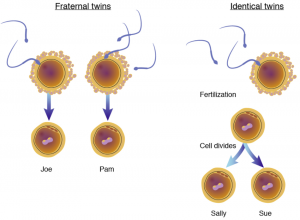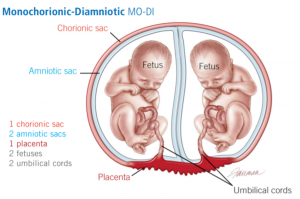I remember being in 10th grade biology class, watching a Bill Nye the Science Guy video, and hearing him say something along the lines of “everyone on the planet is genetically unique!” Wait for it- “Except identical siblings”. There it was. A disclaimer to one of the coolest facts in biology.
As an identical twin myself, I’ve been asked a lot of questions and told a lot of things (some that aren’t necessarily true) regarding twins, from “you can’t share a birthday” in preschool to “how do you think your epigenomes differ now?” in college.

Being a biologist and a primary source on the matter, I thought I’d share my knowledge on the topic of twins (kidding, please see hyperlinks for sources). Let’s first start off with the kinds of twins you might meet. There are two main types: monozygotic and dizygotic. Monozygotic twins are more commonly known as identical twins and are the result of one egg being fertilized by one sperm that then splits. The single fertilized egg, called a zygote, lends its name to monozygotic (hence one zygote). Identical twins, as the name suggests, share all of their genetic information because they came from the same original zygote. Thus, identical twins are always the same sex. It’s important to remember that while genetic identicals, identical twins can still be quite different in personality and behavior due to environmental influence.
The mechanism that pushes a fertilized egg to split into identical twins is not known, and no genetic variants have been linked to identical twins. If the biological mechanism that causes a zygote to split is elucidated, the implications for cloning and scientific studies are vast, since you’d want a genetically identical control for your experiments.
This brings us to dizygotic twins, also known as fraternal twins, which are the results of two separate zygotes occurring during the same pregnancy. Two separate eggs are fertilized by two different sperm cells, therefore they do not share identical DNA and are regular siblings. Fraternal twins, unlike identical twins, can run in families due to genetic variants that can be inherited. Fraternal twins may be the same sex, different sexes, look different from each other, or look similar to each other. See Ashley and Mary Kate Olsen, for example. While I feel like twins should have an innate ability to tell other twins apart, I’m ashamed to say I cannot with the Olsens.
On top of zygotic origins, twins can also receive a classification based on if they share an amniotic sac (amniotic) and placenta (chorionic). A developing fetus is surrounded by 2 membranes: the amniotic sac and the chorionic sac. The inner membrane is called the amniotic sac, which directly surrounds the fetus in utero, and is filled with amniotic fluid. The placenta is a special organ that grows during pregnancy and provides oxygen and nutrients to the developing fetus while also removing waste products from the fetus’s blood. The chorion, or chorionic sac, is part of the placenta and is the outer of the two membranes.
Twins can be monochorionic or dichorionic depending on if they share a placenta or have separate placentas, respectively. Additionally, depending on if twins share an amniotic sac or separate amniotic sacs, twins can be monoamniotic or diamniotic. You can then get all sorts of combinations of these terms. For example, I am a monozygotic twin that was monochorionic and diamniotic in utero. Translation: I am an identical twin that shared a placenta but didn’t share an amniotic sac with my sister during gestation.

While I am a natural clone, I do have some uniqueness. Identical twins still have different fingerprints. Fingerprints and footprints are formed through a combination of genetic and environmental factors, like when a fetus touches the amniotic wall. Even monoamniotic twins (sharing the same amniotic sac) will not have identical fingerprints or footprints. This is why I cannot unlock my sister’s phone through a fingerprint lock (I can unlock her phone with facial recognition, however). I’ve been asked many times “how do you know you and your sister weren’t accidentally switched? What if you’re actually her and she’s actually you?” I don’t believe this has happened to us, but if I ever have an identity crisis, I can go back to the records that have our footprints and fingerprints from when we were processed in the hospital.
And though I’m not a genetically distinct individual, I am an epigenetically unique individual. The epigenome refers to modifications and markers on our DNA that can turn genes “on” and “off”. Certain behaviors and environmental conditions can influence our epigenomes, such as diet and smoking. I’m willing to bet my epigenome looks pretty different from my sister’s because she lived abroad for an extended period of time and was exposed to many different environmental factors during this time. A few years ago, a super cool study was done on one twin who was an astronaut and went to space while his brother stayed on earth. This study looked at how living in space can affect the body and yielded some pretty neat results like changes in gene expression.
Besides identical and fraternal twins, other types of twins you may have heard of include conjoined twins, mirror twins, and Irish twins. Conjoined twins are the result of a single fertilized egg (monozygote) not splitting fully in half. When the twins are born, their bodies are still connected. Mirror twins is a term used to describe identical twins with asymmetrical characteristics, such as one twin being right-handed or having a birthmark on the right side of their face and the other twin being left-handed or having their birthmark on the left side of their face. Irish twins has been a term to describe siblings born within 12 months of each other. I know a set of twins that were actually born on different days because one twin was born just before midnight and his brother was born after midnight. Less common is when twins are born in different years, but every so often a news story comes out featuring a set of twins born on December 31st and January 1st. Talk about a cool fact when it’s time for a group icebreaker!
I hope this article was helpful in answering some questions you may have had regarding twins. And no, we aren’t telepathic, but yes, our favorite color is blue.
Edited by Taylor Tibbs